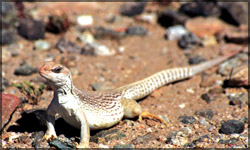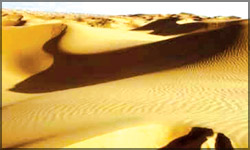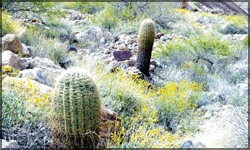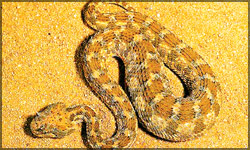The diversity of deserts
 Over
the last few weeks, we've been featuring the different types of biomes
of the world in this page. We have already spoken about two of them, and
today we'll feature the third in the list of six biomes. Over
the last few weeks, we've been featuring the different types of biomes
of the world in this page. We have already spoken about two of them, and
today we'll feature the third in the list of six biomes.
When you hear or see the word desert, what springs to mind
immediately will be hot sunny weather, sand dunes all over the place and
camels. But, did you know that the diversity in a desert biome is second
only to that of a tropical rain forest? Amazing, isn't it? Although this
may be hard to believe, it's the truth.
If your mother is a gardening enthusiast, check whether she has any
cactus plants. A wide variety of cacti is available even at the numerous flower exhibitions. Where do you think
all these plants originated? Yes, they are all from the desert biome.
available even at the numerous flower exhibitions. Where do you think
all these plants originated? Yes, they are all from the desert biome.
Deserts cover about one fifth of the Earth's surface and occur where
the annual rainfall is less than 50cm. There are two major types of
deserts in the world; hot and dry deserts and cold deserts.
There could also be two more sub-types, semi-arid and coastal.
Most deserts, such as the Sahara of North Africa and the deserts of
south western United States, Mexico and Australia, occuring at low
latitudes, are hot and dry deserts, while cold deserts occur in the
basin area in the range of Utah and Nevada in USA, and in parts of
western Asia.
Animals
Most deserts have a considerable amount of specialised vegetation, as
well as specialised vertebrate and invertebrate animals. Soils often
have nutrients because they need only water to become very productive,
and have little or no organic matter. Disturbances are common in the
form of occasional fires or cold weather, and sudden, infrequent, but
intense rains that cause flooding.
 There
are relatively few large mammals in deserts because most animals are not
capable of storing sufficient water and withstanding the heat. Deserts
often provide little shelter from the sun for large animals. The
dominant animals of warm deserts are non-mammalian vertebrates, such as
reptiles. Mammals are usually small, like the kangaroo mice of North
American deserts. There
are relatively few large mammals in deserts because most animals are not
capable of storing sufficient water and withstanding the heat. Deserts
often provide little shelter from the sun for large animals. The
dominant animals of warm deserts are non-mammalian vertebrates, such as
reptiles. Mammals are usually small, like the kangaroo mice of North
American deserts.
When it comes to a hot and dry desert, the name itself implies what
it is. Most deserts of this type don't have many plants. The only
animals which can survive in this enviornment have the ability to hide
under ground. This is because they would not be able to live too long,
exposed to the hot sun and heat. They only come out in the night when it
is a little cooler.
A cold desert is a place that has snow in the winter instead of just
a few degrees drop in temperature, like it happens in a hot and dry
desert. It never gets warm enough for plants to grow, with the exception
of a few grasses and mosses.
The animals in cold deserts also have to hide away, but in their
case, it's to keep warm, and not cool. That is why some of the animals
found in the hot and dry deserts are seen here too.
Cold deserts are located closer to the Arctic Circle. The temperature
in hot and dry deserts ranges from 20 to 25 degrees Celsius. The extreme maximum temperature for hot deserts
ranges from 43.5 to 49 degrees Celsius. The temperature in cold deserts
during winter ranges from -2 to 4 degrees Celsius and in the summer, 21
to 26 degrees Celsius.
25 degrees Celsius. The extreme maximum temperature for hot deserts
ranges from 43.5 to 49 degrees Celsius. The temperature in cold deserts
during winter ranges from -2 to 4 degrees Celsius and in the summer, 21
to 26 degrees Celsius.
The rainfall in the two types of deserts are different. Hot and dry
deserts usually have very little rainfall and/or concentrated rainfall
in short periods, between long rainless periods. This averages out to
less than 15cm a year. Cold deserts usually have lots of snow. During
the winters, there is very little if any rainfall; they also have quite
a bit of snow during winter.
Vegetation
Vegetation is very rare in hot and dry deserts. Plants are almost all
ground-hugging shrubs and short woody trees, with all leaves being
replete (packed with nutrients). Some examples of these plants are
Turpentine Bush, Prickly Pears and Brittle Bush.
In order to survive, all these plants need adaptations for that
particular environment. Some of the adaptations
 in
this case are the ability to store water for long periods of time and
the ability to stand the hot weather. in
this case are the ability to store water for long periods of time and
the ability to stand the hot weather.
In cold deserts however, the plants are scattered. In areas with
little shade, about 10 per cent of the ground is covered with plants.
Animals in the hot and dry deserts include small nocturnal (only active
at night) and carnivorous animals.
There are also insects, arachnids, reptiles, and birds. Some examples
of these animals are borrowers, mourning wheatears and horned vipers.
Cold deserts have animals like antelope, ground squirrels, jack rabbits
and kangaroo rats.
Compiled by Janani Amarasekara |
